#cloud computing with Azure
Explore tagged Tumblr posts
Text
Explore the most popular Azure services and products of 2024. This list outlines the top tools and services businesses rely on for cloud computing, data management, AI, and security, helping you make informed technology choices.
#Azure services 2024#top Azure products#Microsoft Azure cloud#cloud computing with Azure#popular Azure tools.
0 notes
Text
Microsoft Azure Fundamentals
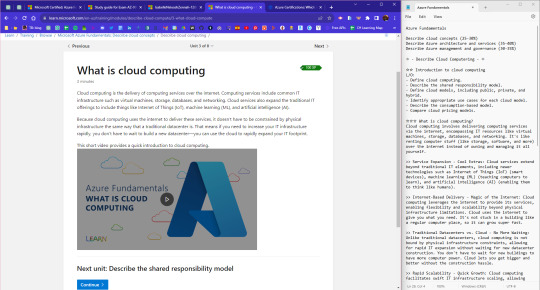
Thursday 17th august 2023
Dad has got me trying to get the Microsoft Azure Fundamentals certification! If you know me, I love my name on certificates so I am trying it out! I haven't been too much into cloud computing so I guess this is a good opportunity to actually learn and see what it's all about.
I know the bare basics that it's storing things not at the company?? Like at work, they store everything in Azure. Again, I may be wrong with the definition - that's why I'm learning!
Learning new things can be fun! ˙˚ʚ(´◡`)ɞ˚˙
#xc: studies#azure studies#codeblr#coding#progblr#programming#studyblr#studying#computer science#microsoft azure#azure certification#tech#cloud computing
31 notes
·
View notes
Text
Secure and Scalable Cloud Server Management at Atcuality
For businesses seeking to enhance scalability and maintain top-tier security, Atcuality provides unparalleled cloud server management services. Our solutions cover all aspects of cloud server maintenance, including load balancing, patch management, data backups, and disaster recovery planning. Our experienced professionals work with cutting-edge tools to ensure that your servers are secure, efficient, and scalable to meet changing business needs. Whether you operate in e-commerce, finance, or technology, we tailor our services to align with your operational goals. With Atcuality as your trusted partner, you can focus on driving growth while we handle the technical complexities of cloud management.
#seo marketing#seo services#artificial intelligence#azure cloud services#seo agency#digital marketing#seo company#iot applications#ai powered application#amazon web services#ai applications#virtual reality#augmented reality agency#augmented human c4 621#augmented and virtual reality market#augmented intelligence#augmented reality#cloud security services#cloud computing#cloud services#cloud service provider#cloud server hosting#software#devops#information technology#cash collection application#task management#blockchain#web developing company#web development
2 notes
·
View notes
Text
2 notes
·
View notes
Text

🚀 Join Us TODAY for an Exclusive Azure DevOps Demo! 🚀
💡 Ready to boost your DevOps skills? Learn about Azure DevOps in our hands-on online demo TODAY at eMexo Technologies! 🎓🔥 PLUS, we're offering an incredible 40% OFF for a limited time! 💥
📅 Don't Miss Out – The clock is ticking! ⏳ Gain real-world insights and start your journey to becoming a DevOps pro! 🛠️
👉 CLICK THE LINK https://www.emexotechnologies.com/courses/microsoft-azure-devops-training-course-az-400/ to secure your spot NOW! 💻✨
📅 25th Sept 2024 🧭 9 PM ( IST )
Format: Online Training
Contact Us For More Info:
📞 Phone: +91 9513216462
��� Website: https://www.emexotechnologies.com/
#azure devops#azure training#devops#cloud computing training#emexotechnologies#bangalore#electroniccity#traininginstitute#e learning#online courses#online training#tech education#tech skills#software training institute
2 notes
·
View notes
Text
Why Cloud Strategy Is So Important for Today's Businesses?
Introduction:
In the rapidly evolving landscape of today's digital age, businesses are constantly seeking innovative ways to stay competitive, efficient, and resilient. Among the transformative technologies that have become indispensable is cloud computing. Cloud strategy and design play a pivotal role in harnessing the full potential of cloud services to drive business success. This article explores why crafting a robust cloud strategy and design is crucial for businesses in the contemporary environment.

Agility and Scalability:
Cloud computing offers unparalleled agility and scalability, allowing businesses to adapt quickly to changing market conditions. A well-defined cloud strategy ensures that organizations can scale their resources up or down based on demand, optimizing costs and performance. This flexibility is particularly vital in industries with fluctuating workloads or seasonal demands.
Cost Efficiency:
Cloud services provide a pay-as-you-go model, eliminating the need for substantial upfront investments in physical infrastructure. A carefully crafted cloud strategy allows businesses to optimize their spending by selecting the most cost-effective services and adjusting resources as needed. This cost efficiency is especially beneficial for startups and small to medium-sized enterprises (SMEs) looking to compete with larger counterparts on a more level playing field.
Innovation and Collaboration:
Cloud environments foster innovation by providing easy access to cutting-edge technologies, such as artificial intelligence, machine learning, and big data analytics. Moreover, cloud platforms enable seamless collaboration among teams, allowing employees to work on projects from anywhere in the world. A well-designed cloud strategy supports innovation by leveraging the latest tools and promoting a collaborative work culture.
Security and Compliance:
Security is a top concern for businesses, and cloud providers invest heavily in advanced security measures. However, a comprehensive cloud strategy involves designing a secure architecture, implementing robust access controls, and ensuring compliance with industry regulations. This proactive approach enhances data protection and builds trust with customers and partners.
Business Continuity and Disaster Recovery:
Unforeseen events, such as natural disasters or cyberattacks, can disrupt traditional business operations. Cloud services provide built-in redundancy and disaster recovery options that contribute to a resilient business model. A well-thought-out cloud strategy includes contingency plans, ensuring that critical data and applications can be quickly restored in the event of an outage or data loss.
Global Reach:
Cloud services allow businesses to expand their reach globally without the need for physical infrastructure in every location. This global accessibility enhances the ability to serve customers worldwide, breaking down geographical barriers and opening new market opportunities. An effective cloud strategy considers the geographic distribution of resources to optimize performance and user experience.
Data Analytics and Business Intelligence:
The vast amounts of data generated by modern businesses hold valuable insights that can drive strategic decision-making. Cloud platforms offer powerful tools for data analytics and business intelligence. A well-designed cloud strategy integrates these tools, enabling businesses to derive actionable insights from their data, leading to informed decision-making and improved performance.
Conclusion:
In conclusion, the importance of cloud strategy and design for today's businesses cannot be overstated. From driving innovation and collaboration to ensuring security and compliance, a well-crafted approach to cloud computing is fundamental to achieving business goals in the digital era. As technology continues to advance, businesses that prioritize and invest in a robust cloud strategy will find themselves better positioned to navigate the challenges and capitalize on the opportunities of the ever-evolving business landscape.
4 notes
·
View notes
Text
My Journey with Azure IoT Hub: Connecting and Managing IoT Devices at Scale
The Internet of Things (IoT), which enables seamless connectivity and automation across numerous industries, has completely changed the way we engage with technology. I was curious to learn more about the Internet of Things and its possible uses as an aspiring IoT enthusiast. My experience using Azure IoT Hub, Microsoft’s cloud-based IoT platform, and how it assisted me in connecting and managing IoT devices at scale are both discussed in this blog.
Getting Started with Azure IoT Hub

To embark on my IoT journey, I began by understanding the fundamentals of Azure IoT Hub. Azure IoT Hub is a fully managed service that acts as a central hub for bi-directional communication between IoT devices and the cloud. It provides secure, reliable, and scalable connectivity for IoT solutions. Setting up an Azure IoT Hub was my first step. While the process was relatively straightforward, I encountered a few challenges along the way.
Connecting IoT Devices
Once Azure IoT Hub was set up, I delved into the world of IoT devices. I worked with various types of IoT devices, ranging from simple sensors to complex industrial machines. Connecting these devices to Azure IoT Hub required the implementation of device-specific protocols such as MQTT or HTTP. Additionally, I focused on securing device connections and data transmission by utilizing security features provided by Azure IoT Hub.
Real-world examples of IoT devices connected to Azure IoT Hub are aplenty. For instance, in the healthcare industry, wearable devices can transmit patient vitals to Azure IoT Hub, allowing healthcare providers to monitor and respond to critical situations promptly. In smart homes, IoT devices such as thermostats and security cameras can be connected to Azure IoT Hub, enabling remote control and monitoring capabilities.
Managing IoT Devices at Scale
As my IoT project grew, I encountered the need to scale up the number of connected devices. Azure IoT Hub offered robust device management features that simplified the process of managing a large fleet of devices. I could remotely monitor the health, status, and firmware version of each device, enabling efficient troubleshooting and maintenance. Implementing best practices for device management, such as grouping devices based on location or functionality, enhanced the overall operational efficiency of my IoT solution.
Data Ingestion and Processing
Data collected from IoT devices is a valuable asset that can drive actionable insights and informed decision-making. Azure IoT Hub facilitated the ingestion and routing of data to Azure services for further processing and analysis. I had the opportunity to work with Azure Stream Analytics and Azure Functions, which enabled real-time data processing, transformation, and visualization. Leveraging these services allowed me to unlock the true potential of IoT data and derive meaningful insights.
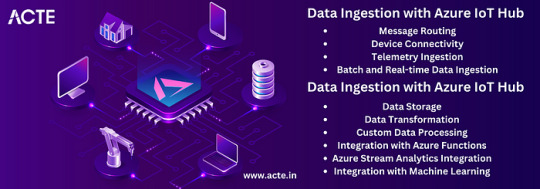
Security and Compliance
Any IoT solution must prioritize security. Azure IoT Hub provided robust security features that ensured end-to-end protection of IoT deployments. These features included device authentication, message encryption, and integration with Azure Active Directory for access control. Additionally, Azure IoT Hub helped me meet compliance and regulatory requirements by providing built-in support for industry standards such as ISO 27001, HIPAA, and GDPR. Throughout my journey, I learned valuable lessons and implemented best practices for securing IoT solutions.
Scalability and Performance
Scaling an IoT solution to handle thousands or millions of devices is a complex task. Azure IoT Hub offered scalability features that allowed me to effortlessly handle large-scale IoT deployments. With Azure IoT Hub’s device-to-cloud messaging capabilities, I could reliably transmit messages to and from a massive number of devices. Moreover, I gained insights into optimizing IoT solutions for performance by considering factors such as message size, frequency, and device capabilities.
Real-World Use Cases
To understand the versatility of Azure IoT Hub, it is crucial to explore real-world use cases. In the manufacturing industry, Azure IoT Hub can be leveraged to connect and monitor machines on the factory floor, ensuring optimal performance and predictive maintenance. In the agriculture sector, IoT devices connected to Azure IoT Hub can collect data on soil moisture levels, temperature, and humidity, enabling farmers to make data-driven decisions for irrigation and crop management. These use cases highlight the valuable role that Azure IoT Hub plays in various domains and industries.
Future of IoT and Azure IoT Hub
The future of IoT is promising, with emerging trends shaping the landscape. As IoT continues to evolve, Azure IoT Hub will play a crucial role in enabling seamless connectivity, advanced analytics, and artificial intelligence capabilities. Integration with other Azure services and continuous updates from Microsoft ensure that Azure IoT Hub remains at the forefront of IoT innovation. The possibilities for IoT applications are limitless, and Azure IoT Hub will continue to empower developers and organizations to build robust and scalable IoT solutions.
Throughout my journey with Azure IoT Hub, I gained valuable insights and experiences. Azure IoT Hub simplified the process of connecting and managing IoT devices, providing a reliable and scalable platform. The seamless integration with other Azure services allowed me to unlock the full potential of IoT data. Moreover, the security and compliance features provided peace of mind, ensuring that my IoT solution was protected from threats. Overall, Azure IoT Hub has been instrumental in my IoT journey, contributing to enhanced efficiency and productivity.
Recommendations and Tips
For those interested in starting their own IoT journey with Azure IoT Hub, I offer the following recommendations and tips:
Begin with a clear understanding of your IoT use case and requirements.
Familiarize yourself with the documentation and resources provided by Microsoft to gain a solid foundation.
Start small and gradually scale your IoT solution as needed.
Take advantage of the device management and security features offered by Azure IoT Hub.
Leverage other Azure services such as Azure Stream Analytics and Azure Functions to derive meaningful insights from IoT data.
Stay updated on emerging trends and best practices in the IoT space.
To deepen your knowledge of IoT and Azure IoT Hub, I recommend exploring Microsoft’s official documentation, participating in the ACTE Technologies Microsoft Azure training, and attending IoT-focused conferences and events.

Azure IoT Hub has proven to be a powerful and comprehensive platform for connecting and managing IoT devices at scale. Throughout my journey, I witnessed the transformative potential of IoT solutions and the crucial role played by Azure IoT Hub in enabling seamless connectivity, advanced analytics, and robust security. As IoT continues to evolve, Azure IoT Hub will undoubtedly remain at the forefront of IoT innovation, empowering organizations to build scalable and efficient IoT solutions. I encourage readers to embark on their own IoT journeys, leveraging the capabilities of Azure IoT Hub to unlock the full potential of IoT. Join me in embracing the future of IoT and revolutionizing industries through connected devices. Please leave your comments, stories, and inquiries in the space provided below. Let’s continue the conversation and explore the endless possibilities of IoT together.
#microsoft azure#cloud services#information technology#education#tech#technology#iot#innovation#cloud computing
5 notes
·
View notes
Text
But I’m sure they’re being totally responsible with AI.
4 notes
·
View notes
Text
#Cloud Computing#Cloud Servers#Disaster Recovery#Virtual Private Server#Multi-Cloud#AWS#Microsoft Azure#Cloud Security#Hosting Solutions
0 notes
Text

Launch Cloud Career with Azure Administration Training at Evision Technoserve
#Azure Administration Training#Azure Administrator Associate AZ-104#Azure Fundamentals AZ-900#Cloud computing skills#Azure Certification to Get Hired in 2025#Best Azure Certification
0 notes
Text
impact de l'ia de microsoft sur les métiers du futur
Chaque minute, des milliers d’entreprises et d’utilisateurs individuels accèdent à une application Microsoft, qu’il s’agisse de taper un e-mail sur Outlook ou de gérer des données complexes sur Azure. Microsoft n’est pas seulement un acteur de la technologie, c’est une superpuissance numérique modelant les façons dont le monde travaille, apprend et se connecte. La suite Office, bien plus qu’un…
0 notes
Text
Quizlet praises me

Saturday 19th August 2023
I'm getting there with my Cloud Computing studies! I am actually remembering things! Okay Loa, don't fall off now!
By the grace of God, I can eventually do some practice exams on this topic of 'Describe cloud computing' o(≧▽≦)o

#xc: studies#codeblr#coding#progblr#programming#studyblr#studying#computer science#microsoft azure#azure certification#tech#cloud computing#azure studies
17 notes
·
View notes
Text
Democratization of Artificial Intelligence
Accessible Artificial Intelligence to All “UAE makes ChatGPT Plus subscription free for all residents as part of deal with OpenAI “ Above mentioned news made headline and a step toward Democratization of Artificial Intelligence. Artificial Intelligence (AI) is no longer a distant vision of the future. it is a daily reality. Personalized recommendations on your phone are changing how we live.…

View On WordPress
#Architecture#Artifiical Intelligence#azure#cloud computing#Democratization of AI#EdTech#GenAI#Machine Learning#Public Cloud#security#technology#Technology opinion
0 notes
Text
Top Certifications That Can Land You a Job in Tech
Published by Prism HRC – Leading IT Recruitment Agency in Mumbai
Breaking into the tech industry doesn’t always require a degree. With the rise of online learning and skill-based hiring, certifications have become the new ticket into some of the highest-paying and most in-demand jobs. Whether you're switching careers or upskilling to stay ahead, the right certification can boost your credibility and fast-track your job search.
Why Certifications Matter in Tech
Tech employers today are less focused on your college background and more interested in what you can actually do. Certifications show you're committed, skilled, and up-to-date with industry trends a huge plus in a fast-moving field like IT.
Let’s explore the top certifications in 2025 that are actually helping people land real tech jobs.

1. Google IT Support Professional Certificate
Perfect for: Beginners starting in tech or IT support This beginner-friendly course, offered through Coursera, teaches you everything from troubleshooting to networking. It’s backed by Google and respected across the industry.
Tip: It’s also a great way to pivot into other IT roles, including cybersecurity and network administration.
2. AWS Certified Solutions Architect – Associate
Perfect for: Cloud engineers, DevOps aspirants With cloud computing continuing to explode in 2025, AWS skills are hotter than ever. This cert proves you know how to design secure, scalable systems on the world’s most popular cloud platform.
Real Edge: Many employers prioritize candidates with AWS experience even over degree holders.
3. Microsoft Certified: Azure Fundamentals
Perfect for: Beginners interested in Microsoft cloud tools Azure is a close second to AWS in the cloud market. If you’re looking for a job at a company that uses Microsoft services, this foundational cert gives you a leg up.
4. CompTIA Security+
Perfect for: Cybersecurity beginners If you're aiming for a job in cybersecurity, this is often the first certification employers look for. It covers basic network security, risk management, and compliance.
Why it matters: As cyber threats grow, demand for cybersecurity professionals is rising rapidly.
5. Google Data Analytics Professional Certificate
Perfect for: Aspiring data analysts This course teaches data analysis, spreadsheets, SQL, Tableau, and more. It’s beginner-friendly and widely accepted by tech companies looking for entry-level analysts.
Industry Insight: Data skills are now essential across tech, not just for analysts, but for marketers, product managers, and more.
6. Certified ScrumMaster (CSM)
Perfect for: Project managers, product managers, team leads Tech teams often use Agile frameworks like Scrum. This certification helps you break into roles where communication, leadership, and sprint planning are key.
7. Cisco Certified Network Associate (CCNA)
Perfect for: Network engineers, IT support, and infrastructure roles If you’re into hardware, routers, switches, and network troubleshooting, this foundational cert is gold.
Why it helps: Many entry-level IT jobs prefer CCNA holders over generalists.

8. Meta (Facebook) Front-End Developer Certificate
Perfect for: Front-end developers and web designers This cert teaches HTML, CSS, React, and design systems. It’s hands-on and offered via Coursera in partnership with Meta.
The bonus? You also get portfolio projects to show in interviews.
How to Choose the Right Certification
Match it to your career goal – Don't do a cert just because it’s popular. Focus on the role you want.
Check job listings – Look at what certifications are frequently mentioned.
Time vs Value – Some certs take weeks, others months. Make sure the ROI is worth it.
- Based in Gorai-2, Borivali West, Mumbai - www.prismhrc.com - Instagram: @jobssimplified - LinkedIn: Prism HRC
#Tech Certifications#IT Jobs#Top Certifications 2025#Cloud Computing#Cybersecurity#Data Analytics#AWS Certification#Microsoft Azure#CompTIA Security+#Prism HRC#IT Recruitment#Mumbai IT#Skill-Based Hiring#Future of Tech#Mumbai IT Jobs#Google IT Support#Google Data Analytics
0 notes
Text
Hybrid Cloud Strategies with Azure Arc: My Practical Insight
Are you ready to unlock the true potential of hybrid cloud strategies? Look no further than Azure Arc, the game-changing solution that promises seamless integration and unparalleled flexibility. From streamlining operations to enhancing security, Azure Arc has revolutionized the way organizations harness the power of both on-premises and cloud environments. In this blog post, I’ll be diving into my practical insights on leveraging Azure Arc for your hybrid cloud journey. So buckle up as we explore the endless possibilities and unveil a new era in hybrid computing!
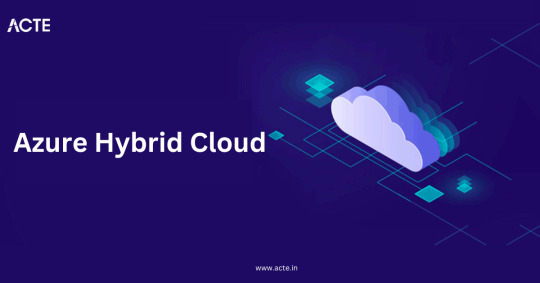
Introduction to Hybrid Cloud Strategies with Azure Arc
I’m under pressure to digitally transform in order to remain competitive. I’m looking to the cloud as a way to accelerate this transformation. Not all workloads, meanwhile, are appropriate for the public cloud. Some may require on-premises or edge computing due to data sovereignty or local regulations. Others may need to be kept on-premises due to performance requirements.
Hybrid cloud strategies allow me to keep some workloads on-premises or at the edge while still taking advantage of the agility and scalability of the public cloud. Azure Arc is a tool that can help me manage and monitor my hybrid cloud deployments. In this blog post, I will share my practical insight into using Azure Arc for my hybrid cloud deployments.
Benefits of Azure Arc Adoption & Challenges in Implementing it
In recent years, using the cloud has grown in popularity among organizations of all sorts. One of the major advantages of cloud computing is its scalability; I can quickly add or remove capacity as needed without making a long-term commitment. Azure Arc is a hybrid cloud solution that allows me to take advantage of the benefits of the cloud while still maintaining control over my data and applications.
There are several benefits to adopting Azure Arc, including:
Increased flexibility and scalability: As mentioned above, one of the major advantages of Azure Arc is its scalability. I can easily add or remove capacity as needed, without making a long-term commitment. This can help me save money on IT infrastructure costs, as well as ensure that I have the necessary resources available when I need them.
Improved disaster recovery: Another benefit of Azure Arc is improved disaster recovery capabilities. With this solution in place, I can quickly recover from outages or disasters with minimal downtime. This can help keep my business up and running even in the event of a major problem.
Enhanced security: Security is always a major concern for me, especially when it comes to sensitive data. With Azure Arc in place, I can take advantage of enhanced security features such as encrypted data storage and multi-factor authentication. This can help give me peace of mind knowing that my data is safe and secure.
Lower maintenance costs: Maintaining on-premises IT infrastructure can be costly and time-consuming. Azure Arc helps me lower maintenance costs by simplifying resource management and automating tasks.
Understanding the Necessary Requirements for Azure Arc Usage
Azure Arc is a cloud management platform that enables me to optimize my hybrid cloud deployments. It provides a unified control plane for managing resources across on-premises, edge, and multi-cloud environments. Azure Arc also simplifies the process of integrating Azure services with on-premises and third-party solutions.
In order to use Azure Arc, I must first have an Azure subscription. I must also have the desired Azure Resource Manager (ARM) template or Resource Manager package deployed in my environment. Azure Arc uses these templates or packages to deploy and manage resources in the target environment.
Once the necessary requirements are met, I can begin using Azure Arc to manage my hybrid cloud deployments. I can use the platform to provision and manage resources, monitor activity and usage patterns, set policies and governance controls, etc. Additionally, I can use Azure Arc to connect my on-premises or third-party solutions with Azure services. This allows me to take advantage of the many benefits that Azure has to offer, such as scalability, high availability, security, and so on.
Steps for Setting Up Azure Arc Configurations
Azure Arc is a cloud service that enables me to manage and monitor my resources whether they’re running on Azure, on-premises, or in other clouds. With Azure Arc, I can use the same tools and portal experiences I’m used to in Azure to centrally govern all my infrastructure.
Setting up an Azure Arc configuration is simple and straightforward. I just need to follow these simple instructions:
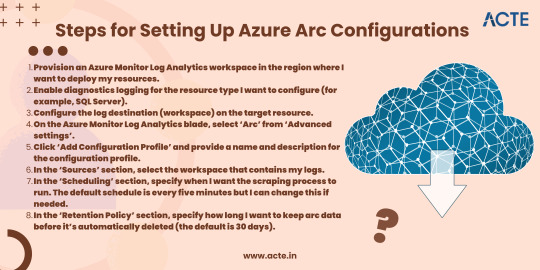
9a. If I want to scrape data from multiple workspaces, I can repeat steps 5–8 for each workspace.
Troubleshooting Common Issues Related to Hybrid Cloud with Azure Arc If I’m working with hybrid cloud and Azure Arc, there are a few common issues I may run into. Here’s how to troubleshoot them:
I can’t see all of my resources in the Azure portal.
Make sure that I’ve selected the correct subscription in the Azure portal. If I’m still not seeing all of my resources, check the resource provider status page to see if there are any known issues.
I’m getting errors when trying to deploy resource group templates.
When deploying resource group templates, make sure that the template includes all required resources for Azure Arc enabled resource providers. Consult the Azure Resource Manager documentation for further details.
My hybrid cloud app isn’t running correctly.
If I’m having trouble with a hybrid cloud app, first check the logs to see if there are any error messages. Then, try redeploying the app using a different approach (for example, using Azure CLI or PowerShell instead of the Azure portal).
Unifying Multiple Clouds with One Platform:
A Comprehensive Overview Azure Arc is a cloud management platform that enables me to unify multiple clouds with one platform. Azure Arc provides a comprehensive overview of my resources and allows for central management and policy enforcement across all of my Azure subscriptions. Azure Arc also provides integrated security and compliance features to help me secure my data and meet regulatory requirements.
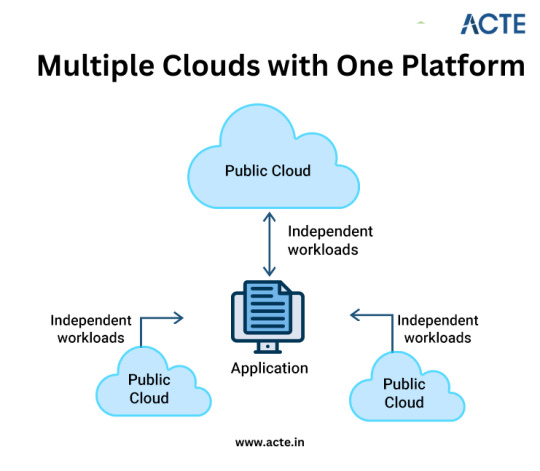
Best Practices for Utilizing Hybrid Cloud Strategies with Azure Arc
When it comes to hybrid cloud strategies with Azure Arc, there are a few best practices that I should keep in mind. For starters, I should make sure that I have a clear understanding of my workloads and how they need to be supported. I should also have a clear picture of my network topology and how the different components will interact with each other. Additionally, it’s important to have a plan for data security and management, as well as monitoring and logging. By keeping these things in mind, I can be sure that my hybrid cloud strategy with Azure Arc is as effective as possible.
All things considered, Azure Arc is an impressive offering from Microsoft that can help me realize the potential of hybrid cloud technology. By leveraging my existing infrastructure while taking advantage of the benefits offered by public clouds like Azure, I can enjoy features such as greater scalability and improved flexibility to meet changing needs. Whether I need basic access control or more advanced policies to manage my distributed systems, my practical insight on using Azure Arc for my hybrid cloud strategy shows how powerful this platform is in streamlining and optimizing cloud operations for various enterprises.
2 notes
·
View notes
Text

5 Key Benefits of Azure Cloud Migration Services
Migrating to the cloud is no longer optional — it's essential. This infographic highlights the top 7 benefits of using Azure Cloud Migration Services for modern businesses. From cost optimization and enhanced security to faster deployment and improved scalability, Microsoft Azure provides a flexible, secure, and efficient platform for digital transformation.
Discover how Azure helps streamline your IT infrastructure while improving business continuity and integration with existing Microsoft tools. Whether you're planning a full migration or hybrid setup, these insights will help you understand why Azure is the platform of choice.
#Azure Cloud#Cloud Migration#Azure Migration Services#Microsoft Azure#Cloud Computing#IT Modernization#DevOps#Cloud Strategy
0 notes